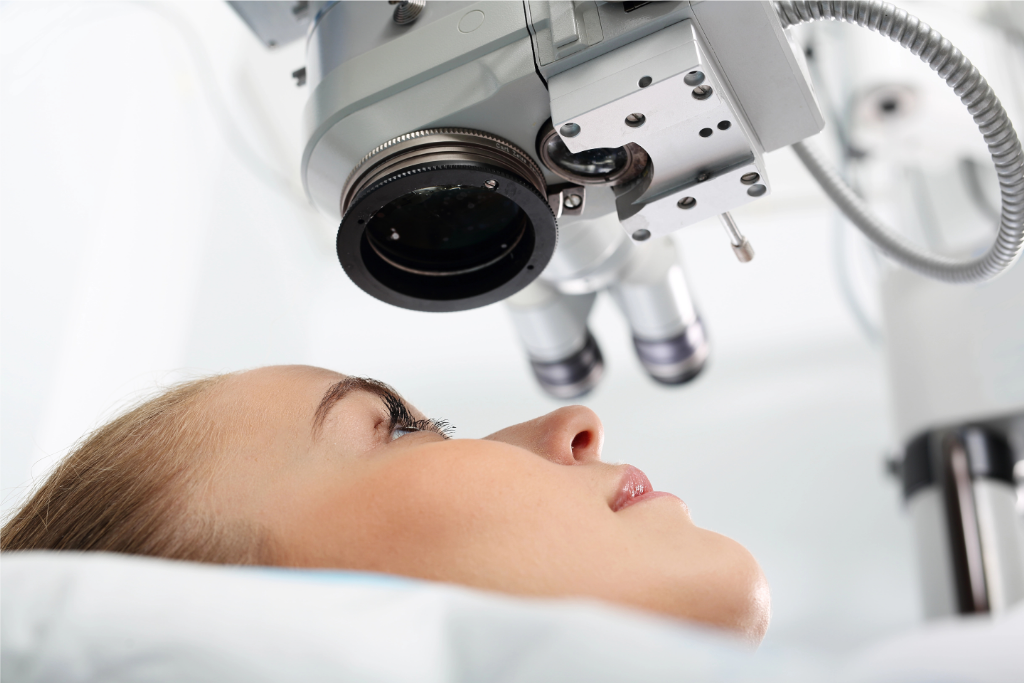Already had eye surgery but still struggling with glasses or blurry vision? You might wonder if LASIK in Los Angeles is still an option. Many patients in Los Angeles, and even those in Newport Beach, Beverly Hills, and Glendale, find themselves asking this very question. We’ll address the common concern of whether LASIK is safe or effective after procedures like cataract surgery, PRK, or RK, offering clarity for those with a history of eye surgery who are exploring further vision correction.
Understanding LASIK and What It Does
LASIK is a popular laser vision correction procedure designed to reshape the cornea, the clear front surface of your eye. This reshaping helps to correct refractive errors such as nearsightedness (myopia), farsightedness (hyperopia), and astigmatism, reducing or eliminating the need for glasses or contact lenses.
To be eligible for traditional LASIK, certain basics must be met. These typically include having healthy corneas with sufficient thickness, stable vision for at least a year, and the absence of active eye conditions or systemic diseases that could affect healing.
LASIK After Cataract Surgery: Is It Possible?
Is LASIK safe after eye procedures? The short answer is: yes, in many cases, undergoing LASIK after cataracts is indeed possible, provided you are a suitable candidate. Cataract surgery involves removing the eye’s natural, cloudy lens and replacing it with an artificial intraocular lens (IOL). While this significantly improves vision, some individuals may still experience residual refractive error, leading to the need for glasses for certain tasks.
You might still need LASIK after cataract surgery for several reasons:
- Residual refractive error after IOL (intraocular lens) placement: Even with precise calculations, the final refractive outcome after cataract surgery can sometimes leave a patient with mild nearsightedness, farsightedness, or astigmatism.
- Desire for sharper vision without glasses: Many patients who have undergone cataract surgery are keen to further reduce or eliminate their dependence on glasses, especially for distance vision.
When considering LASIK after cataracts, timing is an important factor:
- It’s generally recommended to wait 3–6 months after cataract surgery to allow the eye to fully stabilize. This ensures that the measurements taken for potential LASIK are accurate.
- Accurate measurements of corneal shape and your current prescription are important for successful LASIK enhancement.
Modern LASIK techniques allow for custom enhancements following cataract surgery. This means the laser treatment can be specifically tailored to address any remaining refractive error, potentially leading to even clearer vision. If you’re in Beverly Hills or elsewhere in the Los Angeles area and have had cataract surgery, discussing this option with an eye specialist in Los Angeles is a good next step.
What About Other Eye Procedures?
LASIK After PRK (Photorefractive Keratectomy)
Generally, having LASIK after PRK is not recommended. Both procedures work by reshaping the cornea using a laser. Undergoing a second corneal refractive surgery like LASIK after PRK may not be the best approach, as the initial surface ablation of PRK might have already limited the amount of corneal tissue available for further reshaping. In such cases, alternative enhancement procedures might be more suitable. Patients in Glendale who have had PRK and are seeking further vision correction should explore these alternatives with their eye doctor.
LASIK After RK (Radial Keratotomy)
LASIK after RK (Radial Keratotomy), an older procedure involving radial incisions on the cornea, is more complex. Eyes that have undergone RK can sometimes exhibit corneal instability and unpredictable healing patterns. Therefore, LASIK is often not the ideal solution in these cases. Other options, such as PRK or lens-based solutions, might be preferred for vision correction following RK. Consulting an experienced Eye Specialist in Los Angeles is important for those who have had RK and are now considering LASIK or other corrective procedures.
LASIK After ICL (Implantable Contact Lens)
It’s rare to need LASIK after having an ICL (Implantable Collamer Lens) implanted. ICLs are designed to provide significant vision correction. However, if a residual refractive error exists after ICL implantation, LASIK could potentially be considered in some specific situations. In such cases, a thorough assessment of corneal thickness and overall eye health is paramount. If you are in Newport Beach or any other location and have an ICL but still desire further refinement of your vision, discuss all available options with your ophthalmologist.
Also Read: Is LASIK Right for You? What to Know Before You Ditch Your Glasses
LASIK Candidacy After Surgery: What Your Eye Doctor Will Evaluate
If you’re considering LASIK after a previous eye surgery, your eye doctor will conduct a comprehensive evaluation, taking several factors into account:
- Corneal thickness and curvature: Ensuring there is enough healthy corneal tissue for safe reshaping.
- Presence of dry eye or inflammation: These conditions can affect the outcome of LASIK.
- Type of prior surgery and when it was done: Understanding the previous procedure helps determine the suitability for LASIK.
- Stability of your vision: Vision should be stable for a certain period before considering LASIK.
- Overall eye health: Assessing the health of your macula, retina, and optic nerve is necessary.
Alternatives to LASIK for Post-Surgical Vision Correction
If LASIK isn’t the best option after your previous eye surgery, several alternatives for vision correction exist.
- PRK or ASA (Advanced Surface Ablation): These surface-based laser procedures might be suitable in some cases where LASIK isn’t recommended.
- Piggyback lenses or lens exchange: These involve adding or replacing an existing intraocular lens.
- Toric or multifocal IOL adjustment/replacement: If you’ve had cataract surgery, adjusting or replacing the IOL could address residual refractive errors.
- Refractive lens exchange (RLE): If you haven’t had cataract surgery, RLE involves replacing your natural lens with an artificial one to correct refractive errors.
Risks and Considerations
Undergoing LASIK after a previous eye surgery may carry slightly different risks compared to primary LASIK. These can include:
- A potentially slightly higher risk of complications depending on your surgical history.
- The presence of pre-existing corneal scarring or instability from the prior procedure.
- The necessity for detailed diagnostic imaging to plan the treatment accurately.
It’s also important to have realistic expectations about the potential outcomes of LASIK after other eye procedures.
Conclusion
LASIK can be an option after cataract surgery and certain other eye surgeries. However, whether LASIK is safe after eye procedures depends entirely on your individual circumstances and a thorough evaluation by an experienced eye specialist in Los Angeles.
If you’ve had prior eye surgery and are exploring LASIK or other avenues for further vision correction, we encourage you to schedule a comprehensive consultation with our team, at Soroudi Advanced LASIK and Eye Centers. We serve patients in Los Angeles, Newport Beach, Beverly Hills, Glendale, and surrounding areas, and we can help you determine the best path to achieving your optimal vision.



